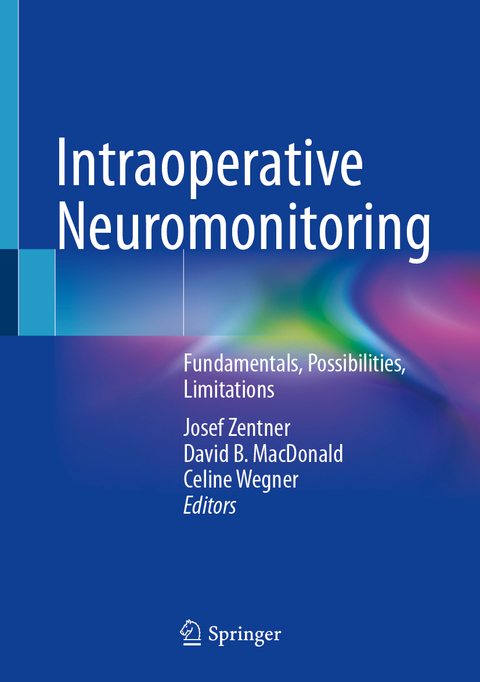
Intraoperative Neuromonitoring
Springer International Publishing (Verlag)
978-3-031-46124-8 (ISBN)
Josef Zentner received his neurosurgical training at the Department of Neurosurgery, University of Freiburg, Germany. He completed his PhD in neurophysiology with studies on intraoperative motor evoked potential monitoring at the Department of Neurosurgery in Tübingen. A fellowship in the USA and Canada acquainted him with epilepsy surgery. As the vice chairman of the Department of Neurosurgery in Bonn he took over the surgical part of the epilepsy surgical program in 1990 and was appointed to a professorship (C3) 1994. In 1997 he received full professorship (C4) and chair of the Department of Neurosurgery, University of Freiburg. In collaboration with the epilepsy center Kehl/Kork, Dr. Zentner established a grade IV center for epilepsy surgery in Freiburg. Neurophysiology and epilepsy surgery continued to be the main areas of his interest. In 2003 Dr. Zentner was appointed president of the German chapter of the International League Against Epilepsy (ILAE). In addition, he served as dean of the Medical Faculty of the University of Freiburg from 2003 to 2005. Dr. Zentner was active on several editorial boards and published many articles on various aspects of neurophysiology and epilepsy surgery. Among other research foundations, his scientific work was supported by the DFG. Dr. Zentner retired in 2018. Over the past years, he summarized his experience with epilepsy surgery in his 2020 monograph, Surgical Treatment of Epilepsies - Diagnosis, Surgical Strategies, Results.
Dr. David MacDonald trained in medicine and neurology at Dalhousie University, Halifax, Nova Scotia, Canada. He then studied electroencephalography (EEG) and evoked potentials (EPs) at the MAYO Clinic, Rochester, Minnesota, United States. He was Director of the intraoperative neurophysiologic monitoring (IONM) program, EEG/EP laboratory, and seizure investigation unit at the University of British Columbia in Vancouver, Canada from 1991 to 1999, and became an assistant clinical professor of neurology. Then he headed the Section of Neurophysiology in the Department of Neurosciences at the King Faisal Specialist Hospital & Research Center in Riyadh, Saudi Arabia from 2000 to 2012, and remained as consultant intraoperative neurophysiologist, neurologist, and epileptologist until 2020. In 2021, he became Scientific Director for Arkana Forum in Emmendingen, Germany to focus on IONM education and training. Dr. MacDonald is also a past President of the International Society of Intraoperative Neurophysiology (ISIN), and its current Scientific Committee Co-Chair. His main fields of expertise include IONM, EEG, EPs, epilepsy, teaching, research, and guideline development. He is a frequently requested speaker, and has published many articles and chapters, including guidelines for the ISIN, the American Society of Clinical Neurophysiology, and the American Society of Neurophysiologic monitoring. In addition, he is Associate Editor of Clinical Neurophysiology, the official journal of the International Federation of Neurophysiology, as well as an Editorial Board member for the Journal of Clinical Neurophysiology and the Journal of Clinical Monitoring and Computing.
Celine Wegner received her Master of Science degree in the field of Biomedical Engineering from Furtwangen University in 2014. From 2014 till 2020 she worked in the Research Department of inomed Medizintechnik focusing her work on new methods of nerve stimulation and neurophysiologic recording. In 2016 she joined ARKANA Forum as scientific support, responsible for the content support in the development of teaching material and of educational events. 2020 to 2021 she was the managing director of iNCU, a company with 8 employees providing intraoperative neuromonitoring as a service to hospitals. Here the focus of her work was on development of the company as well as personnel, especially training of new employees. I
1 Introduction: 1.1 Why neuromonitoring.- 1.2 Historical aspects.- 1.3 Monitoring concept.- 1.4 Monitoring team.- 2 Anatomical and Physiological Fundamentals: 2.1 Positional and directional designations.- 2.2 The nervous system.- 2.3 Musculoskeletal system: 2.4 Test questions.- 3 Measurement Technique: 3.1 Physical parameters.- 3.2 Stimulation.- 3.3 Signal acquisition.- 3.4 Test questions.- 4 Technical Accessoires: 4.1 Stimulation and recording electrodes.- 4.2 Special accessories.- 5 Modalities and Methods: 5.1 Electroencephalography (EEG).- 5.2 Electromyography (EMG).- 5.3 Electroneurography (ENG).- 5.4 Evoked potentials (EP).- 5.5 Functional-topographic mapping.- 5.6 Cranial nerves.- 5.7 Spinal nerves.- 5.8 Reflexes.- 5.9 Autonomic nervous system.- 5.10 Test questions .- 6 Perioperative Management: 6.1. Patient preparation.- 6.2. System preparation.- 6.3. General conduct rules in the operating room (OR).- 6.4. Measurement processes.- 7 Anesthesia and IONM: 7.1 Effect of anesthetics on the nervous system.- 7.2 Anesthetics and electrophysiology.- 7.3 Awake craniotomy.- 7.4 Test questions.- 8 Application of Intraoperative Neuromonitoring: 8.1 Interpretation of the potential findings.- 8.2 IONM in Neurosurgery.- 8.3 IONM in Orthopedic surgery.- 8.4. IONM in Vascular surgery.- 8.5. IONM in General surgery.- 8.6 IONM in Otolaryngology.- 9 Efficiency of Intraoperative Neuromonitoring.- 10 Safety: 10.1 Introduction.- 10.2 Electrical safety.- 10.2.4 Fire.- 10.3 Procedure-specific safety.- 10.3.5 Other procedures.- 10.4 Infection control.- 10.5 Essential performance.- 10.6 Conclusions.- 10.7 Test questions.- 11 Troubleshooting.- 12 Addendum: 12.1 List of figures.- 12.2 List of tables.- 12.3 Glossary.- 12.4 Literature.
| Erscheinungsdatum | 19.12.2023 |
|---|---|
| Zusatzinfo | XXXIII, 227 p. 277 illus., 265 illus. in color. |
| Verlagsort | Cham |
| Sprache | englisch |
| Maße | 178 x 254 mm |
| Themenwelt | Medizinische Fachgebiete ► Chirurgie ► Neurochirurgie |
| Schlagworte | anesthesia • electromyography • Electroneurography • electrophysiology • evoked potentials • Functional topographic mapping • nervous system • Neuromonitoring |
| ISBN-10 | 3-031-46124-X / 303146124X |
| ISBN-13 | 978-3-031-46124-8 / 9783031461248 |
| Zustand | Neuware |
| Informationen gemäß Produktsicherheitsverordnung (GPSR) | |
| Haben Sie eine Frage zum Produkt? |
aus dem Bereich


